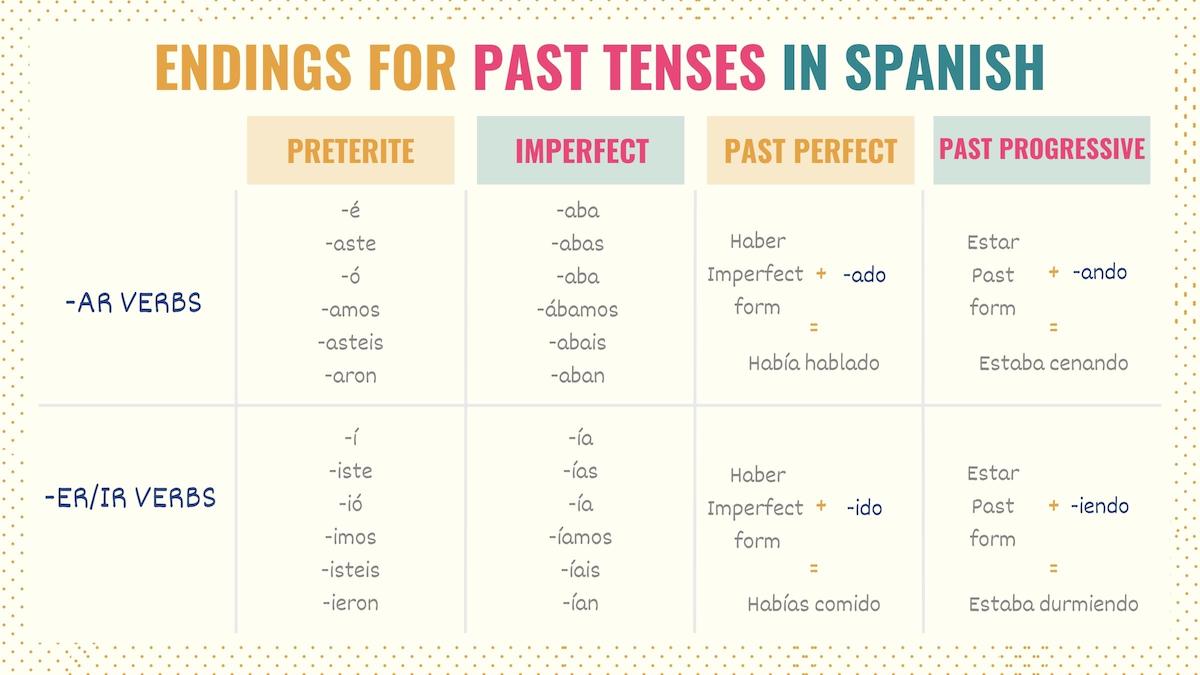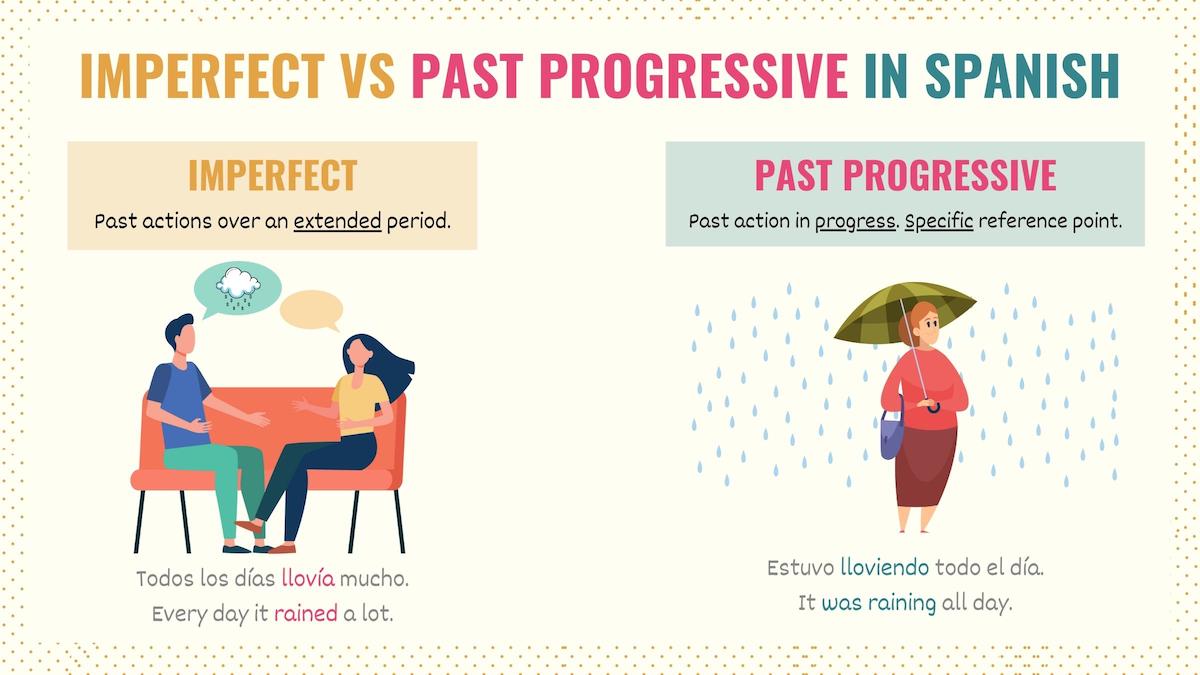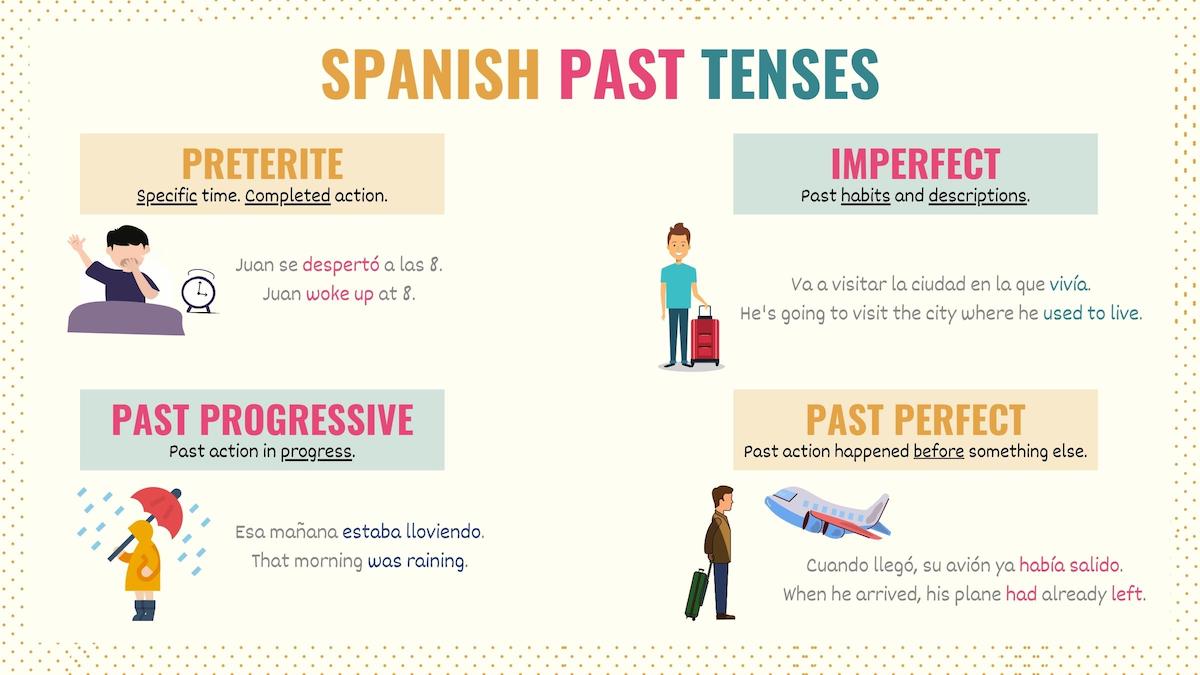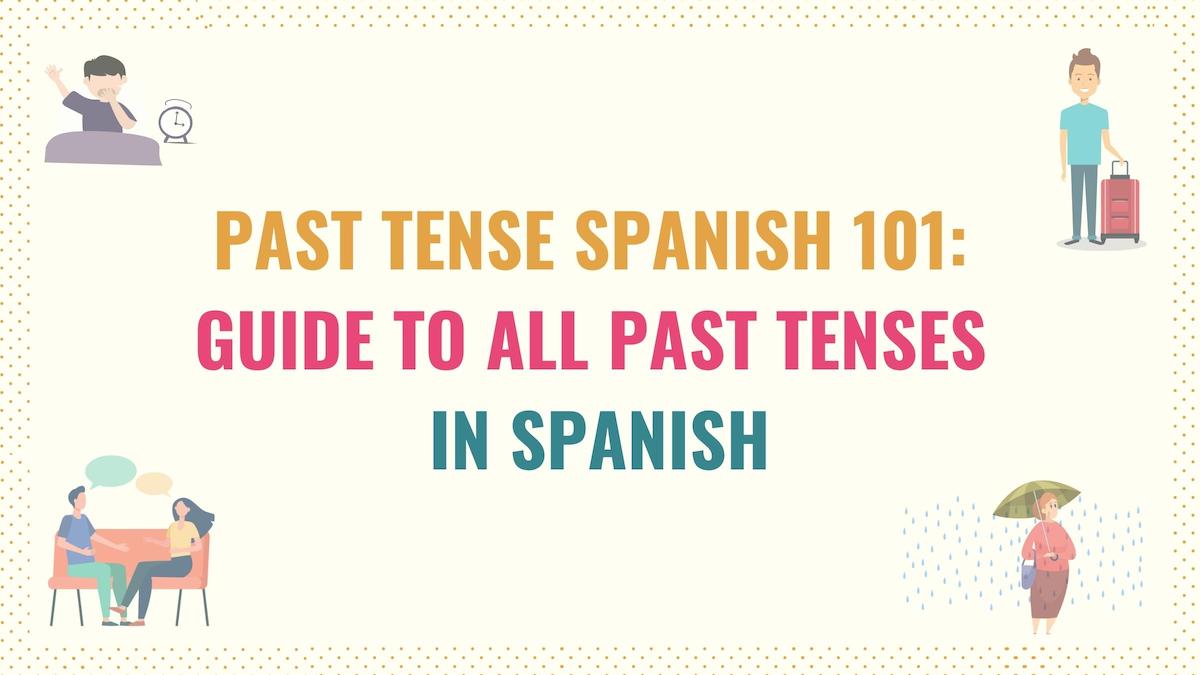Like in any other language, the past in Spanish is crucial for daily communication. Using the past form is crucial to talk about what happened a few minutes ago or share a memory. But there are different conjugation patterns you can use. As a result, in this past tense Spanish guide, you’ll learn:
- How to Conjugate Past Tenses in Spanish
- Using Different Past Tenses
- Key Points
- Additional Resources to Talk in the Past
To become conversationally fluent, you cannot overlook any of the Spanish past tenses. To make things easier, I’ve included real-life examples and additional resources to help you master this topic.
Endings for Past Tenses in Spanish
In Spanish, there are four past tenses:
- Past preterite
- Imperfect tense
- Past perfect
- Past progressive
The Spanish past perfect tense is formed with an auxiliary verb and a past participle. In other words, the formula for this tense is haber in imperfect form + past participle. The past participle in Spanish is formed with the endings -ado (AR verbs) and -ido (ER and IR verbs).
Here is a conjugation chart:
| Person | AR Verb | ER / IR Verb |
|---|---|---|
| Yo | Había hablado | Había bebido |
| Tú | Habías hablado | Habías bebido |
| Él / Ella Usted | Había hablado | Había bebido |
| Nosotros | Habíamos hablado | Habíamos bebido |
| Vosotros | Habíais hablado | Habíais bebido |
| Ellos / EllasUstedes | Habían hablado | Habían bebido |
On the other hand, the past endings for the preterite and the imperfect tense are:
-AR Verbs
| Person | Preterite | Imperfect |
|---|---|---|
| Yo | -é | -aba |
| Tú | -aste | -abas |
| Él / Ella Usted | -ó | -aba |
| Nosotros | -amos | -ábamos |
| Vosotros | -asteis | -abais |
| Ellos / EllasUstedes | -aron | -aban |
ER and IR Verbs
| Person | Preterite | Imperfect |
|---|---|---|
| Yo | -í | -ía |
| Tú | -iste | -ías |
| Él / Ella Usted | -ió | -ía |
| Nosotros | -imos | -íamos |
| Vosotros | -isteis | -íais |
| Ellos / EllasUstedes | -ieron | -ían |
Finally, the past progressive is formed using the past forms of estar and a present participle (-ando, -endo). For instance:
| Person | AR Verb | ER / IR Verb |
|---|---|---|
| Yo | Estaba limpiando | Estaba viviendo |
| Tú | Estabas limpiando | Estabas viviendo |
| Él / Ella Usted | Estaba limpiando | Estaba viviendo |
| Nosotros | Estábamos limpiando | Estábamos viviendo |
| Vosotros | Estabais limpiando | Estabais viviendo |
| Ellos / EllasUstedes | Estaban limpiando | Estaban viviendo |
Although they all refer to the past in Spanish, each of these tenses is used in specific situations. In the sections below, you’ll learn more about these differences.

Take Note: Even though it refers to an action that started in the past, the present perfect is often not considered a past tense because it also refers to or has relevance in the present.
When to Use Different Spanish Past Tenses
As their name suggests, Spanish past tenses convey that an action occurred in the past. However, they differ in how they convey the message and what they focus on.
Below is a more detailed explanation of when and how to use each tense:
Past imperfect
When it comes to past tenses in Spanish, the imperfect is used to provide background information. In simple terms, to describe past circumstances or how something used to be. Some time markers that work with tense are:
- Cuando: When
- Nunca: Never
- Siempre: Always
- Todos los días: Every day
Here are some sentences:
Yo siempre me despertaba temprano.
I always woke up early.
Nuestra escuela era muy bonita.
Our school was very pretty.
La tienda estaba cerrada.
The store was closed.
Take Note: In English, the imperfect tense can be translated as ‘used to’ or ‘was’. However, this tense is only used when referring to past habits or descriptions.
Preterite tense
In Spanish, the preterite tense is the equivalent of the simple past. As a result, we use it to refer to finished actions or events that took place at a specific moment in the past. For example:
No dormí bien.
I didn’t sleep well.
Los vecinos fueron a la playa.
The neighbors went to the beach.
¿Por qué le dijiste eso?
Why did you say that to her?
Because it refers to specific moments, the time markers for the preterite tense are words such as ayer, la semana pasada, hace dos años, etc.
Take Note: The preterite and imperfect are usually confused with each other because they share the same translation. However, these are complementary tenses.
Spanish past perfect
Use the past perfect when explaining that a past action happened before something else. This tense can also be used to talk about first-time experiences:
Sally nunca había ido a la playa.
Sally had never gone to the beach before.
Mis hermanos ya habían terminado de comer.
My brothers had already finished eating.
Spanish past progressive
In Spanish, we use the past progressive (also called the past continuous) to express that an action was in progress at some moment (the event went on for a while). This tense can be used to provide additional background information or to communicate that a past was interrupted by another one:
Ayer estuvo lloviendo todo el día.
Yesterday it was raining all day.
Cuando me fui, Larry estaba limpiando la cocina.
When I left, Larry was cleaning the kitchen.
Take Note: Like the imperfect, the past continuous can also provide background information about the past. However, the imperfect focuses on events that happened for an extended period of time, whereas the past progressive refers to actions in progress.

Key Points
These four past tenses are equally important to form coherent sentences. In other words, you need to understand how and when to use them.
Here is a table where you can compare side by side the past tenses in Spanish:
| Tense | Uses | Examples |
|---|---|---|
| Preterite | – Completed actions in the past. – Activities that occurred at a specific time in the past. | Ayer hablé con ella. Yesterday I talked to her. |
| Imperfect | – Describes how things or people were. – Talks about past habits or recurrent actions. – Tells time and age. | La casa era grande. The house was big. |
| Past Perfect | – Expresses that a past action took place before something else. | Ya la había visto. I had seen it already. |
| Past Progressive | – Refers to actions that were interrupted by another past event. – Describes past actions that were in progress. | No estaba viendo la tele. I wasn’t watching TV. |

Next Steps: Past Tense Spanish Additional Resources
Here are some resources you can check to improve your command of the Spanish past tenses:
- Guide to imperfect vs preterite: These tenses are commonly confused among Spanish learners because they often share the same translation. In this guide, you’ll learn the different contexts where you need to use them.
- How & When to Use the Preterite: This guide is meant to help you understand the most common uses of the preterite in Spanish. You’ll also learn how to conjugate regular and irregular verbs and trigger words, among other things.
- Guide to the Past Perfect in Spanish: As a compound tense, the past perfect is formed with two elements. Click here to learn the uses and conjugations of this tense.
- Guide to the Spanish Imperfect Tense: In this guide, you’ll find the most common scenarios where you must use the past imperfect. Additionally, we’ll go over time markers and conjugations.
These conjugation patterns are only meant to help you communicate in the past. Other Spanish tenses that will help you place an action at different moments in time.
Download the Spanish Past Tenses PDF
Spanish grammar topics like tenses and conjugations can seem overwhelming to new learners. However, talking about the past in Spanish is a must and learning these tenses is key to your conversational fluency. I’ve created a free PDF you can download with all the graphics and key points from this guide so you can review the tenses as you learn Spanish.



